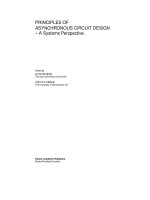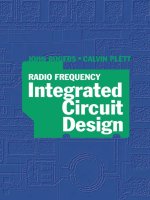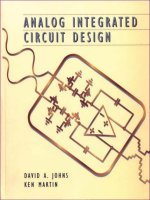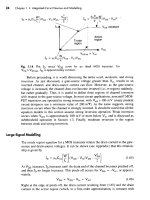Asynchronous circuit design
Bạn đang xem bản rút gọn của tài liệu. Xem và tải ngay bản đầy đủ của tài liệu tại đây (38.65 MB, 419 trang )
Asynchronous
Circuit Design
Asynchronous Circuit Design. Chris J. Myers
Copyright
2001 by John Wiley & Sons, Inc.
ISBNs: 0-471-41543-X (Hardback); 0-471-22414-6 (Electronic)
Asynchronous
Cikuit
Design
Chris J. Myers
A
Wilcplnterscience Publication
JOHN WILEY 8z SONS, INC.
New York / Chichester
/ Weinheim / Brisbane / Singapore / Toronto
Asynchronous Circuit Design. Chris J. Myers
Copyright
2001 by John Wiley & Sons, Inc.
ISBNs: 0-471-41543-X (Hardback); 0-471-22414-6 (Electronic)
Copyright 2001 by John Wiley and Sons, Inc., New York. All rights
reserved.
No part of this publication may be reproduced, stored in a retrieval system
or transmitted in any form or by any means, electronic or mechanical,
including uploading, downloading, printing, decompiling, recording or
otherwise, except as permitted under Sections 107 or 108 of the 1976
United States Copyright Act, without the prior written permission of the
Publisher. Requests to the Publisher for permission should be addressed to
the Permissions Department, John Wiley & Sons, Inc., 605 Third Avenue,
New York, NY 10158-0012, (212) 850-6011, fax (212) 850-6008, E-Mail:
PERMREQ @ WILEY.COM.
This publication is designed to provide accurate and authoritative
information in regard to the subject matter covered. It is sold with the
understanding that the publisher is not engaged in rendering professional
services. If professional advice or other expert assistance is required, the
services of a competent professional person should be sought.
ISBN 0-471-22414-6.
This title is also available in print as ISBN 0-471-41543-X.
For more information about Wiley products, visit our web site at
www.Wiley.com.
To Ching and John
Preface
Acknowledgments
I Introduction
1
I. 1 Problem Specification
1
1.2 Communication Channels 2
1.3 Communication Protocols
4
1 .,J Graphical Representations
8
1.5 Delay-Insensitive Circuits
10
1.6 Hujjfman Circuits
13
I. 7 Muller Circuits
16
1.8 Timed Circuits
17
1.9 Verification
20
1.10 Applications
20
1.11 Let’s Get Started
21
1.12 Sources
21
Problems
22
2 Communication Channels
23
2.1 Basic Structure
24
Contents
xiii
xvii
Asynchronous Circuit Design. Chris J. Myers
Copyright
2001 by John Wiley & Sons, Inc.
ISBNs: 0-471-41543-X (Hardback); 0-471-22414-6 (Electronic)
. . .
VIII CONTENTS
2.2 Structural Modeling in VHDL
27
2.3 Control Structures
31
2.3.1
Selection
31
2.3.2 Repetition
32
2.4 Deadlock
34
2.5 Probe
35
2.6 Parallel Communication
35
2.7 Example: MiniMIPS
36
2.7.1 VHDL Specification
38
2.7.2
Op timixed MiniMIPS
48
2.8
Sources
52
Problems
53
3 Communication Protocols
57
3.1 Basic Structure
57
3.2 Active and Passive Ports
61
3.3 Handshaking Expansion
61
3.4 Reshufling
65
3.5 State Variable Insertion
66
3.6 Data Encoding
67
3.7 Example: Two Wine Shops
71
3.8 Syntax-Directed Translation
73
3.9
Sources
80
Problems
82
4 Graphical Representations
4.1 Graph Basics
4.2
Asynchronous Finite State Machines
42.1
Finite State Machines and Flow Tables
42.2
Burst-Mode State Machines
4.2.3
Extended Burst-Mode State Machines
4.3 Petri Nets
43.1 Ordinary Petri Nets
4.3.2 Signal Transition Graphs
,J .d Timed Event/Level Structures
4.5
Sources
Problems
85
85
88
88
91
93
100
100
111
116
120
121
CONTENTS ix
5 Hunman Circuits
5.1 Solving Covering Problems
5.1.1 Matrix Reduction Techniques
5.1.2 Bounding
5.1.3 Termination
5.1 .d Branching
5.2 State Minimization
5.2.1
Finding the Compatible Pairs
5.2.2 Finding the Maximal Compatibles
5.2.3 Finding the Prime Compatibles
5.2.4 Setting Up the Covering Problem
5.2.5 Forming the Reduced Flow Table
5.3 State Assignment
5.3.1 Partition Theory and State Assignment
5.3.2 Matrix Reduction Method
5.3.3 Finding the Maximal Intersectibles
5.34 Setting Up the Covering Problem
5.3.5 Fed-Back Outputs as State Variables
5.4 Hazard-Free Two-Level Logic Synthesis
54.1 Two-Level Logic Minimization
5.4.2 Prime Implicant Generation
54.3 Prime Implicant Selection
5.4 4 Combinational Hazards
5.5 Extensions for MIC Operation
5.5.1 Transition Cubes
5.5.2 Function Hazards
5.5.3 Combinational Hazards
5.54 Burst-Mode Transitions
5.5.5 Extended Burst-Mode Transitions
5.5.6 State Minimization
5.5.7 State Assignment
5.5.8 Hazard-Free Two-Level Logic Synthesis
5.6 Multilevel Logic Synthesis
5.7 Technology Mapping
5.8 Generalized
C-Element Implementation
5.9 Sequential Hazards
5.10
Sources
Problems
131
132
134
137
137
138
140
141
143
145
148
154
154
155
157
158
161
163
165
165
166
168
169
171
172
172
173
176
177
180
183
183
188
189
193
194
196
199
CONTENTS
6 Muller Circuits
207
6.1 Formal Definition of Speed Independence
208
61.1 Subclasses of Speed-Independent Circuits
210
6.1.2 Some Useful Definitions
212
6.2 Complete State Coding
216
6.2.1 Transition Points and Insertion Points
217
6.2.2 State Graph Coloring
219
6.2.3 Insertion Point Cost Function
220
6.2.4 State Signal Insertion
222
6.2.5 Algorithm for Solving CSC Violations
223
6.3 Hazard- Free Logic Synthesis
223
6.3.1 Atomic Gate Implementation
225
6.3.2 Generalized C-Element Implementation
226
6.3.3 Standard C-Implementation
230
6.3.4 The Single- Cube Algorithm
238
6.4
. Hazard-Free Decomposition
243
6.4.1
Insertion Points Revisited
245
6.4.2 Algorithm for Hazard-Free Decomposition
246
6.5 Limitations of Speed-Independent Design
248
6.6
Sources
249
Problems
251
7 Timed Circuits
259
7.1 Modeling Timing
260
7.2 Regions
262
7.3 Discrete time
265
7.4
Zones
267
7.5 POSET Timing
280
7.6 Timed Circuits
289
7.7
Sources
292
Problems
293
8 Verification
295
8.1 Protocol Verification
296
8.1.1 Linear- Time Temporal Logic
296
8.1.2 Time- Quantified Requirements
300
8.2 Circuit Verification
303
8.2.1 Trace Structures
303
CONTENTS
xi
8.2.2 Composition 305
8.2.3 Canonical Trace Structures
308
8.2.4 Mirrors and Verification
310
8.2.5 Strong Conformance
312
8.2.6 Timed Trace Theory
314
8.3 Sources
315
Problems 316
9 Applications
9.1 Brief History of Asynchronous Circuit Design
9.2 An Asynchronous Instruction-Length Decoder
9.3 Performance Analysis
94
9: 5
Testing Asynchronous Circuits
The Synchronization Problem
9.5.1 Probability of Synchronixation Failure
9.5.2 Reducing the Probability of Failure
9.5.3 Eliminating the Probability of Failure
95.4 Arbitration
9.6 The Future of Asynchronous Circuit Design
9.7 Sources
Problems
321
322
325
329
330
332
334
335
336
340
341
342
346
Appendix A VHDL Packages
A. 1 nondeterminism.vhd
A.2 channel.vhd
A.3 handshake.vhd
347
347
348
355
Appendix B Sets and Relations
359
B.i Basic Set Theory
360
B.2 Relations
362
References
365
Index
393
Preface
An important scientific innovation rarely makes its way by gradually winning
over and converting its opponents: it rarely happens that Saul becomes Paul.
What does happen is that its opponents gradually die out and that the growing
generation is familiarized with the idea from the beginning.
-Max Planck
I must govern the clock, not be governed by it.
-Golda Meir
All pain disappears, it’s the nature of my circuitry.
-nine inch nails
In 1969, Stephen Unger published his classic textbook on asynchronous circuit
design. This book presented a comprehensive look at the asynchronous design
methods of the time. In the 30 years hence, there have been numerous techni-
cal publications and even a few books [37, 57, 120, 203, 224, 267, 363, 3931, but
there has not been another textbook. This book attempts to fill this void by
providing an updated look at asynchronous circuit design in a form accessible
to a student who simply has some background in digital logic design.
An asynchronous circuit is one in which synchronization is performed with-
out a global clock. Asynchronous circuits have several advantages over their
synchronous counterparts, including:
. . .
XIII
xiv
1.
2.
3.
4.
5.
6.
PREFACE
Elimination of clock skeul problems. As systems become larger, increas-
ing amounts of design effort is necessary to guarantee minimal skew in
the arrival time of the clock signal at different parts of the chip. In an
asynchronous circuit, skew in synchronization signals can be tolerated.
Average-case performance. In synchronous systems, the performance
is dictated by worst-case conditions. The clock period must be set to
be long enough to accommodate the slowest operation even though the
average delay of the operation is often much shorter. In asynchronous
circuits, the speed of the circuit is allowed to change dynamically, so the
performance is governed by the average-case delay.
Adaptivity to processing and environmental variations. The delay of a
VLSI circuit can vary significantly over different processing runs, supply
voltages, and operating temperatures. Synchronous designs have their
clock rate set to allow correct operation under some allowed variations.
Due to their adaptive nature, asynchronous circuits operate correctly
under all variations and simply speed up or slow down as necessary.
Component modularity and reuse. In an asynchronous system, compo-
nents can be interfaced without the difficulties associated with synchro-
nizing clocks in a synchronous system.
Lower system power requirements. Asynchronous circuits reduce syn-
chronization power by not requiring additional clock drivers and buffers
to limit clock skew. They also automatically power-down unused compo-
nents. Finally, asynchronous circuits do not waste power due to spurious
transitions.
Reduced noise. In a synchronous design, all activity is locked into a very
precise frequency. The result is nearly all the energy is concentrated
in very narrow spectral bands at the clock frequency and its harmon-
ics. Therefore, there is substantial electrical noise at these frequencies.
Activity in an asynchronous circuit is uncorrelated, resulting in a more
distributed noise spectrum and a lower peak noise value.
Despite all these potential advantages, asynchronous design has seen lim-
ited usage to date.
Although there are many reasons for this, perhaps the
most serious is a lack of designers with experience in asynchronous design.
This textbook is a direct attempt at addressing this problem by providing a
means for graduate or even undergraduate courses to be created that teach
modern asynchronous design methods. I have used it in a course which
includes both undergraduates and graduates.
Lectures and other material
used in this and future courses will be made available on our Web site:
http : //www . async. elen. Utah. edu/book/. This book may also be used for
self-study by engineers who would like to learn about modern asynchronous
PREFACE xv
design methods. Each chapter includes numerous problems for the student to
try out his or her new skills.
The history of asynchronous design is quite long. Asynchronous design
methods date back to the 1950s and to two people in particular: Huffman
and Muller. Every asynchronous design methodology owes its roots to one of
these two men. Huffman developed a design methodology for what is known
today as fundamental-mode circuits [ 1701. Muller developed the theoretical
underpinnings of speed-independent circuits [279]. Unger is a member of the
“Huffman School,” so his textbook focused primarily on fundamental-mode
circuit design with only a brief treatment of Muller circuits. Although I am a
student of the “Muller School,” in this book we present both design methods
with the hope that members of both schools will grow to understand each
other better, perhaps even realizing that the differences are not that great.
Since the early days, asynchronous circuits have been used in many in-
teresting applications.
In the 1950s and 1960s at the University of Illinois,
Muller and his colleagues used speed-independent circuits in the design of
the ILLIAC and ILLIAC II computers [46]. In the early days, asynchronous
design was also used in the MU-5 and Atlas mainframe computers. In the
1970s at Washington University in St. Louis, asynchronous macromodules
were developed [87]. These modules could be plugged together to create nu-
merous special-purpose computing engines. Also in the 1970s asynchronous
techniques were used at the University of Utah in the design of the first oper-
ational dataflow computer [102, 1031 and at Evans and Sutherland in design
of the first commercial graphics system.
Due to the advantages cited above, there has been a resurgence of inter-
est in asynchronous design. There have been several recent successful de-
sign projects. In 1989, researchers at Caltech designed the first fully asyn-
chronous microprocessor [251, 257, 2581. Since that time, numerous other
researchers have produced asynchronous microprocessors of increasing com-
plexity [lo, 13, 76, 134, 135, 138, 191, 259, 288, 291, 324, 379, 4061. Commer-
cially, asynchronous circuits have had some recent success. Myranet uses asyn-
chronous circuits coupled with pipeline synchronization [348] in their router
design. Philips has designed numerous asynchronous designs targeting low
power [38, 136, 192, 1931. Perhaps the most notable accomplishment to come
out of this group is an asynchronous 8OC51 microcontroller, which is now used
in a fully asynchronous pager being sold by Philips. Finally, the RAPPID
project at Intel demonstrated that a fully asynchronous instruction-length
decoder for the x86 instruction set could achieve a threefold improvement
in speed and a twofold improvement in power compared with the existing
synchronous design [141, 142, 143, 144, 330, 3671.
In the time of Unger’s text, there were perhaps only a handful of pub-
lications each year on asynchronous design. As shown in Figure 0.1, this
rate of publication continued until about 1985, when there was a resurgence
of interest in asynchronous circuit design [309]. Since 1985, the publication
rate has grown to well over 100 technical publications per year. Therefore,
xvi
PREFACE
170
160
150
140
130
120
iii 110
E
g 100
2 90
5
b 80
e 70
ii 60
50
40
30
20
10
0
1960 1970 1980 1990
Year of publication
4
L.
4
! 1
El
2000
Fig. 0.1
Number of asynchronous publications per year.
although Unger did a superb job of surveying the field, this author has his
work cut out for him. In the sources section at the end of each chapter, the
interested reader is pointed to an extensive bibliography (over 400 entries)
to probe deeper. Although an attempt has been made to give a flavor of the
major design methodologies being developed and used, it is impossible even to
reference every paper published on asynchronous design, as the number of en-
tries in the asynchronous bibliography [309]
now exceeds 1400. The interested
reader should consult this bibliography and the proceedings from the recent
symposiums on asynchronous circuits and systems [14, 15, 16, 17, 18, 19, 201.
The book is organized as follows. In Chapter 1 we introduce the asyn-
chronous design problem through a small example illustrating the differences
among the various timing models used. In Chapter 2 we introduce the con-
cept of asynchronous communication and describe a methodology for spec-
ifying asynchronous designs using VHDL. In Chapter 3 we discuss various
asynchronous protocols. In Chapter 4 we introduce graphical representations
that are used for asynchronous design. In Chapter 5 we discuss Huffrnan cir-
cuits and in Chapter 6 we describe Muller circuits. In Chapter 7 we develop
techniques for timing analysis and optimization which can lead to significant
improvements in circuit quality. In Chapter 8 we introduce methods for the
analysis and verification of asynchronous circuits. Finally, in Chapter 9 we
give a brief discussion of issues in asynchronous application.
CHRIS J. MYERS
Salt Lake City, Utah
Acknowledgments
I am indebted to Alain Martin and Chuck Seitz of Caltech, who turned me
onto asynchronous design as an undergraduate. I would also like to thank
my graduate advisors, Teresa Meng and David Dill of Stanford University,
who taught me alternative ways of looking at asynchronous design. My for-
mer officemate, Peter Beerel (USC), through numerous heated discussions
throughout the years, has taught me much.
I would like to thank Erik Brunvand (Utah), Steve Nowick (Columbia), Pe-
ter Beerel (USC), Wendy Belluomini (IBM), Ganesh Gopalakrishnan (Utah),
Ken Stevens (Intel), Charles Dike (Intel), Jim Frenzel (U. of Idaho), Steven
Unger (Columbia), Dong-Ik Lee (K JIST) ,
and Tomohiro Yoneda (Titech) for
their comments and advice on earlier versions of this manuscript. I’m also
grateful to the comments and ideas that I received from my graduate students:
Brandon Bachman, Jie Dai, Hans Jacobson, Kip Killpack, Chris Krieger,
Scott Little, Eric Mercer, Curt Nelson, Eric Peskin, Robert Thacker, and Hao
Zheng. I would like to thank the students in my course on asynchronous cir-
cuit design in the spring of 2000 for putting up with the rough version of this
text. I am grateful to Sanjin Piragic for drawing many of the figures in the
book. Many other figures are due to drawastg by Jordi Cortadella (UPC)
and
dot
by Eleftherios Koutsofios and Stephen North (AT&T).
I would like especially to thank my family, Ching and John, for being
patient with me while I wrote this book. Without their love and support, the
book would not have been possible.
C.J.M.
xvii
Asynchronous
Circuit Design
Index
A
Absolute complement, 361
Absorbed, 167
Absorption, 188, 362
Acknowledge, 4, 57, 61
Actions, 116
Active, 6, 61
Adjacent, 87
Advance time, 271, 314
Adverse example, 280
AFSM, 89
See also asynchronous finite state
machine
Aliases, 42
Allowed sequences, 208
See also trace
Always operator, 297
timed, 303
AMULET, 323
Antisymmetric, 36c1., 363
Arbiter, 340
Arbitration, 340
See also synchronization
Arc, 86
Architecture, 25
Assert statement, 59
Assign, 4, 59, 63
Associative, 188, 362
Asymmetric
choice nets, 108
confusion, 107
Asynchronous
circuit design
future?, 341
history, 322
finite state machines, 8, 88
handshake, 2
instruction-length decoder, 325
See also RAPPID
microprocessors, 323
AMULET, 323
Caltech, 323
pager, 324
timing, 2
Atomic gate, 225
implementation, 225
Attribute, 27
Autofailure, 309
manifestation., 308
Average-case
logic optimization, 327
performance analysis, 329
B
Base functions, 190
BCP algorithm, 134
See also covering problem
393
Asynchronous Circuit Design. Chris J. Myers
Copyright
2001 by John Wiley & Sons, Inc.
ISBNs: 0-471-41543-X (Hardback); 0-471-22414-6 (Electronic)
.394 INDEX
bounding, 137
branching, 138
example, 149
reduction, 135
termination, 137
Binary
decision diagram, 198
relations, 362
Binate covering problem, 133
Bipartite graph, 88
Blocks, 155
BM machines, 92
See also burst-mode
edge-labeling functions, 92
maximal set property, 92
state diagram, 92
unique entry point, 92
Boolean
matching, 191
matrix, 157
Bounded
delay, 14
gate and wire delay, 132
response time, 300
thn.hg ca.w,t,aSn,t., 1 l! 8, 2fN
Bounding, 137
Branching, 138
Bridging fault model, 332
Buffer, 58
Bundled data, 61
Bundling constraint, 62
Burst-mode, 196
See also BM machines
generalized C-elements, 193
hazard-free logic synthesis, 183
hazards, 176
multilevel logic synthesis, 188
sequential hazards, 194
state assignment, 183
state machines, 91
state minimization, 180
synthesis, 171
technology
maPPi%
transition,
176
189
c
CALL module, 74
Caltech asynchronous microprocessor, 323
Candidate implicant, 233
Canonical
DBM, 268
trace structure, 310
Case statements, 31
Causal, 281
Chain, 363
Change diagrams, 111, 121
Channel, 3, 23
active, 61
init-channel, 25, 28
package, 25, 348
passive, 6 1
port, 61
probe, 35
receive, 26
parallel, 36
send, 26
parallel, 35
type, 25
VHDL modeling, 24
Characteristic marking, 102
Choke, 3 10
Circuit verification, 303
Class set, 145
Clause, 133
Closed, 148
cover, 148
system, 25
Closure, 145
clause, 235
constraint, 148
“wctim, 235
Column dominance, 136
Combinational
hazards
burst-mode, 176
dynamic 0 -+ 1, 170
dynamic 1 -+ 0, 170
extended burst-mode, 177
multiple-input change, 173
single-input change, 169
static O-hazard, 169
static l-hazard, 169
optimization, 228, 236
Communicating sequential processes, 21
Communication
channels, 3
See also channel
basic structure, 24
protocols, 4
See also handshake
Jm.sti ,sf2 w.h.w, 23
Communitive, 362
Compatibility table, 141
Compatible
conditionally, 142
list, 144
maximal, 140
output, 141
pairs, 140-141
prime, 140, 145
states, 13
unconditionally, 141
INDEX
395
Complement, 167
Complete .
circuit, 11, 208
state code, 216
state coding, 216
algorithm, 223
insertion point cost function, 220
insertion points, 217
state graph coloring, 219
state signal insertion, 222
transition points, 217
sums, 167
Completely specified part it ion, 156
Component, 25
declarations, 29
instantiations, 29
Composition, 305
Compulsory transit ion, 94
Concurrent, 106
statement section, 25
Conditional
clause, 95
input bursts, 95
Conditionally compatible, 142
Conflict, 107
relation, 116, 119
Conformance, 20, 303, 308
Conformation equivalent, 308
Conforms, 303, 308
Confusion, 107
asymmetric, 108
symmetric, 108
Consensus, 167
Consistent
signal sets, 305
state assignment, 113
Constraint matrix, 133
Contain, 165
Context signals, 214, 240, 242
Conv-integer, 27
Correctness constraints, 231
Counterflow pipeline, 324
Cover, 148, 166, 230
Covering
clause, 234
constraint, 148, 231, 237
violation, 241
problem, 132
See also BCP algorithm
binate, 133
context signals, 241-242
prime implicant selection, 168
speed-independent logic synthesis, 234
state assignment, 161
state minimization, 148
unate, 133
section, 235
Critical race, 155
CSC solver algorithm, 223
Cube, 165
approximations, 315
Cycle, 87
simple, 87
Cyclic core, 137
D
Data
encoding
bundled data, 61
dual-rail, 58, 67
hazards, 49
Data-driven processors, 323
DC-set, 165
Dead, 103
Deadlock, 34, 66
Declaration section, 25
Decomposition, 190
See
also technology mapping
insertion points, 245
speed-independent, 243
Delay, 26, 59
elements, 11
fault model, 332
faults, 330
problem of the first kind, 251
Delay-insensitive circuits, 11
limits, 12
Delayed-reset domino, 342
DeMorgan’s theorem, 188, 362
Deterministic, 32
Dichotomies, 156
Difference bound matrix, 268
Digraph
acyclic, 88
simple, 88
Direct transition, 155
Directed
acyclic graph, 88
don’t cares, 93
edge, 86
graph, 86
Disabling rules, 118
Discrete-time, 265
example, 265
worst-case complexity, 265
Disengageable strong precedence arcs, 121
Disjoint, 361
collection, 361
Distance 1 apart, 171
Distributive, 167, 188, 362
state graphs, 214
Domain, 362
396
INDEX
Dual-rail, 67
protocol, 58
Duals, 362
Dummy timer, 268
Dynamic
0 -+ 1 hazard
multiple-input change, 175
single-input change, 170
0 + 1 transition, 169
1 + 0 hazard
multiple-input change, 175
single-input change, 170
1 + 0 transition, 169
function hazard, 173
hazard-free
compatible, 181
implicant, 185
prime implicant, 185
hazards
generalized C-elements, 193
multiple-input change, 175
E
Edges, 86
Empty set, 361
Enable module, 74
Enabled, 102, 118
event, 118
Enabling event, 118
End
cube, 177
point, 172
subcube, 178
transitions, 217
Enters, 87
Entity, 25
Entrance constraint, 231, 237
violation, 241
Enumerated types, 25
Environment, 4
Equilibrium, 112
Equipotential regions, 249
Equivalence
class, 363
relation, 363
Equivalent, 209
Essential
hazard, 195
primes, 168
rows, 134
variable, 134
Evans and Sutherland, 323
Events, 10, 116, 260
Eventually operator, 297
timed, 303
Excitation
cube, 238
region, 213
states, 212
Excited, 112
Expired, 118, 260
Extended
burst-mode, 93
See also XBM machines
dynamic hazard problem, 179
generalized C-elements, 193
hazard-free logic synthesis, 183
hazards, 177
multilevel logic synthesis, 188
sequential hazards, 194
state assignment, 183
state machines, 93
state minimization, 180
synthesis, 171
technology mapping, 189
transition, 177
free-choice nets, 108
Extensions, 250
F
Failure
exclusion, 310
traces, 304
Failure-free, 307
Fault model
bridging, 332
delay, 332
isochronic fork, 331
stuck-at, 331
Faults, 330
Feedback delay requirement, 195
Finite state machine, 88
Mealy machine, 89
Moore machine, 89
Firing sequence, 102
Flow relation, 100
Floyd’s algorithm, 269
Followed, 209
For loop, 33
Formal verification, 20
Four-phase handshaking, 5, 64
Fractional component, 262
Free-choice nets, 107
Function, 363
hazard, 172
dynamic, 173
static, 173
Fundamental-mode, xv, 132, 195
G
Gate sharing, 237
Generalized
INDEX
397
C-elements, 193, 226
burst-mode, 193
extended burst-mode, 193
speed-independent, 226
transition cube, 177
Glitch, 165
Globally
asynchronous locally synchronous, 338
synchronous locally asynchronous, 338
Good extension, 250
Graph, 85
basic definitions, 85
bipartite, 88
connected, 87
directed, 86
order, 87
size, 87
strongly connected, 88
undirected, 86
Graphical representations, 8, 85
Greatest
lower bound, 364
member, 364
Guard, 4, 59, 63
Guard-and, 18, 60
Guard-or, 59
Handshake, 2
assign, 59
guard, 59
guard-and, 60
guard-or, 59
package, 58, 355
protocols, 57
vassign, 60
Handshaking expansion, 61
dual-rail encoding, 67
four-phase, 64
lazy-active, 65
probe, 71
reshuffling, 65
state variable insertion, 66
two-phase, 62
VHDL modeling, 58
Hazard, 13, 165
burst-mode, 176
dynamic 0 + 1, 170
dynamic 1 + 0, 170
dynamic function, 173
extended burst-mode, 177
function, 172
generalized C-elements, 193
preserving transformations, 188
static 0, 169
static 1, 169
static function, 173
Hazard-free
decomposition
algorithm, 246
speed-independent, 243
logic synthesis
atomic gate implementation, 225
burst-mode, 183
extended burst-mode, 183
generalized C-element implementation,
226
multiple-input change, 183
single-cube algorithm, 238
single-input change, 165
speed-independent, 223
standard C-implementation, 230
Hierarchical verification, 308
Hold time, 2, 195, 334
Huffman, xv
circuits, 13, 131
flow table, 8, 90
school, 131
I
I-nets, 111
Idempotent, 167, 362
Adsle~t*~, 362
Identity, 362
If-then-else statements, 31
ILLIAC II, xv, 322
Image, 363
Implicant, 166
candidate, 233
excitation region, 231
Implied
state, 113
states, 232
value, 112
In, 28
transition, 155
Incident
from, 87
on, 87
to, 87
Incompatible, 141
Incompletely specified
Boolean function, 165
partition, 156
Infinite loop, 33
Initial
marking, 100
state, 116
Initially rnarked rules, 116
Init-channel, 28
Inout, 28
Input, 4
398
INDEX
burst, 91
condition al, 95
Insertion point, 217
complete state coding, 217
cost function, 220
decomposition, 245
filters, 246
Instruction statistics, 327
Interface nets, 121
Intersect, 361
Intersectible, 159
Intersection, 158, 165, 361
Into, 363
Inverse, 362
delete, 305
IPCMOS, 345
Isochronic fork, 16
fault model, 331
J
Joins, 87
K
K-bounded Petri net, 103
Karnaugh maps, 14
L
LO-live, 103
Ll-live, 103
L2-live, 103
L3-live, 103
L4-live, 103
Labeled Petri net, 100
Lazy-active, 65
Least
member, 364
upper bound, 364
Leaves, 87
Level, 10
expression, 118
signaling, 5, 64
Library, 25
Linear
inequalities, 268
ordering, 363
Linear-time temporal logic, 296
Literal, 165
Live, 103, 111
Petri net, 103
Liveness, 103
Lk-live, 104
Logic
minimization, 131, 165
optimization
average-case, 327
synthesis
burst-mode, 183
combinational hazards, 169
extended burst-mode, 183
multiple-input change, 183
prime implicant generation, 166
prime implicant selection, 168
single-input change, 165
speed-independent, 223
two-level, 165
Loop, 33
Lower bound, 364
algorithm, 137
LTL formulas
checking validity, 298
M
M-nets, 111, 120
Macromodules, xv, 322
Marked graph, 107
component, 110
Marking, 9, 100
Matching/covering, 190
Matrix reduction method, 157
Maximal
compatibles, 140, 143
inde-pendent set,, 137
intersectible, 159
member, 364
set property
BM machine, 92
XBM machines, 94, 96
Mealy machine, 89
Mean time between failure, 335
Member, 360
Merge gate, 73
Metastable state, 333
Microprocessors
asynchronous, 323
AMULET, 323
Caltech, 323
Minimal
member, 364
state, 214
MiniMIPS example, 36
block diagram, 36
channel-level diagram, 38
decode block, 43
dmem block, 47
execute block, 45
fetch block, 42
imem block, 41
instruction formats, 36
optimized, 48
decode block, 49
structural VHDL code, 39
write-back process. 52
INDEX
399
Minimum-transition-time
state assignment, 155
Minterm, ‘165
Mirror, 310
Model checking, 20, 296
Modeling timing, 260
Monotonicity, 314
Moore machine, 89
Muller, xv, 322
C-element, 7
circuits, 16, 207
school, 207
Multilevel logic synthesis
burst-mode, 188
extended burst-mode, 188
multiple-input change, 188
Multiple-input change, 132
See also burst-mode and extended
burst-mode
combinational hazards, 173
dynamic hazards, 175
hazard-free logic synthesis, 183
multilevel logic synthesis, 188
sequential hazards, 194
state assignment, 183
state minimization, 180
static hazards, 174
synthesis, 171
technology mapping, 189
Mutual exclusion element, 337
CMOS circuit, 338
N
wary relations, 362
Next state operator, 296
Nonadjacent, 87
Noncritical race, 155
Nondeterminism
delay, 26, 59
package, 25, 32, 347
selection, 26, 32
Nondeterministic, 32
Nondisabling rules, 118
Normal flow table, 155, 173
Normalize, 271
0
OFF-set, 165
ON-set, 165
One-to-one, 363
Onto, 363
Open
generalized transition cube, 177
transition cube, 172
Ordered
n-tuple, 362
pair, 362
partitions, 159
triple, 362
Ordinary Petri net, 100
Others, 32
Out, 28
output, 4
burst, 91
compatible, 141
semi-modular, 212
stuck-at fault model, 331
P
Packages, 25
Pair chart, 141
Parallel
communication, 35
composition
syntax-directed translation, 78
Partial order, 315, 363
Partially ordered set, 280, 363
Partition, 155
list, 156
theory, 155
Partitioning, 190
Passive, 6, 61
Peephole optimizations, 78
See also syntax-directed translation
call module optimization, 78
enable module optimization, 78
merge module optimization, 78
select module optimization, 78
Performance analysis, 329
average-case, 329
Persistent, 111
Petri net, 9, 85, 100
See also signal transition graph
asymmetric
choice nets, 108
classifications, 107
dead, 103
enabled, 102
firing sequence, 102
flow relation, 100
free-choice nets, 107
extended, 108
initial marking, 100
k-bounded, 103
LO-live, 103
Ll-live, 103
L2-live, 103
L3-live, 103
L4-live, 103
labeled, 100
live, 103
liveness, 109
400 INDEX
Lk-live, 104
marked graph, 107
marking, 100
characteristic, 102
MG component, 110
ordinary, 100
places, 100
postset, 100
preset, 100
reachability graph, 104
reachable, 102
markings, 102
safe, 103
safety, 109
SM component, 110
state machines, 107
transition, 100
Philips pager, 324
Pipeline synchronization, xv, 345
Pipelining, 48
Places, 100
Port, 61
declarations, 27
map, 30
modes, 28
type, 28
POSET, 280
algorithm , 280
example, 281
matrix, 280
timing, 280
Possible traces, 304
Postset, 100
Power set, 361
Prefix-closed trace structure, 304
Premature firing, 331
Premax, 271
Preset, 100
Prime compatibles, 140, 145
algorithm, 145
Prime implicant, 166
essential, 168
generation, 166
select ion, 168
Principle
of abstraction, 360
of duality, 362
of extension, 360
Privileged cubes, 175, 184
Probe, 35
handshaking expansion, 61, 71
Process statement, 26
Product, 165
Progress, 314
Project, 270
Propagation delay, 334
Proposit ion al logic, 296
Protocol verification, 296
Q
Q-flop, 345
Q-modules, 345
Quantum synchronizers, 345
Quasi-delay insensitive, 16, 323
See also speed-independent
Quiescent states, 213
Quotient set, 363
R-related, 209
R-sequence, 209
Racing, 155
Range, 362
RAPPID, xv, 325, 343
microarchitecture, 327
tag unit, 328
RAW hazard, 49
Reachability graph, 104
Reachable, 87, 102
markings, 102
Recanonicalizat ion, 269
Receive, 26
parallel, 36
syntax-directed translation, 76
Receptive, 304
Reduce algorithm, 135
Reduction, 135
Reflexive, 360, 363
Region function, 230
Regions, 262
example, 262
worst-case complexity, 265
Register locking, 49
Relative
complement, 36 1
timing, 316
Renaming, 305
Repetition, 31-32
for loop, 33
infinite loop, 33
while loop, 33
Reply, 322
Request, 4, 57, 61
Required cubes, 174-175, 184
Reset region, 213
Reshuffling, 6, 65
Response time, 334
Restrict, 270
p-related to, 362
Row
covers, 158
dominance, 135
INDEX
401
includes, 158
length, 138
Rules, 116, 260
S
Safe, 111
Petri net, 103
substitute, 312
Safety failures, 3 14
Satisfied, 118, 260
Scan paths, 332
Selection, 26, 31
case, 31
deterministic, 31
function, 32
if-then-else, 31
non-deterministic, 32
syntax-directed translation, 76
Selector module, 73
Self-checking, 331
Self-reference, 40 1
Self-reset ing domino, 342
Self-timed, 249
See
also speed-independent
Semi-modular, 212
output, 212
Send, 26
parallel, 35
syntax-directed translation, 76
Sensitivity list, 35
Sequencing event, 116
Sequential
composition
syntax-directed translation, 77
hazard, 194
hazards
burst-mode, 194
extended burst-mode, 194
multiple-input change, 194
Set, 360
builder notation, 360
region, 213
Setup time, 2, 195, 334
Shared row assignments, 197
Shortest path problem, 269
Signal
assignment
syntax-directed translation, 74
in TEL structure, 116
in VHDL, 25
transition graph, 100, 111
See
also Petri net
Simple
ordering, 363
path, 87
Simply ordered set, 363
Single-cube algorithm, 238
Single-cycle transitions, 112
Single-input change, 132
combinational hazards, 169
hazard-free logic synthesis, 165
state assignment, 154
state minimization, 140
Siphon, 109
Skew-tolerant codes, 80
Specification, 4
Speed-independent, xv-16, 209, 322
See
also Muller circuitsquasi-delay
insensitive, and self-timed
atomic gate implementation, 225
complete state coding, 216
formal definition, 208
generalized C-element implementation,
226
hazard-free decomposition, 243
hazard-free logic synthesis, 223
limitations, 248
output semi-modular, 212
semi-modular, 212
single-cube algorithm, 238
standard C-implementation, 230
totally sequential, 210
Stable, 155, 238
state, 90
Standard C-implementation, 230
Start
cube, 177
point, 172
subcube, 178
transitions, 217
State, 208
minimization
burst-mode, 180
assignment, 14, 131
burst-mode, 183
extended burst-mode, 183
multiple-input change, 183
outputs as state variables, 163
single-input change, 154
diagram, 89, 209
graph, 112, 207, 210
coloring, 2 19
labeling function, 112
machine, 85
component, 110
machines, 107
minimization, 14, 131
extended burst-mode, 180
multiple-input change, 180
single-input change, 140
signal insertion, 222
transitions, 112
402 INDEX
variable, 12, 66
Static
0 + 0 transition, 169
1 + 1 transition, 169
O-hazard
multiple-input change, 174
single-input change, 169
l-hazard
multiple-input change, 174
single-input change, 169
function hazard, 173
hazards
multiple-input change, 174
Std-logic, 25, 58
std-logic-vector, 25
STG properties
live, 111
persistent, 111
safe, 111
single-cycle transit ions, 112
Stoppable clock, 336
Strong
conformance, 314
precedence arcs, 121
until operator, 296-297
Strongly connected, 88
Structural
modeling, 27
pattern matching, 190
Stubborn sets, 315
Stuck-at fault model, 331
output, 331
Subset, 360
Success traces, 304
Sum-of-products, 165
SUN counterflow pipeline, 324
Switching region, 213
Symmetric, 360, 363
confusion, 107
difference, 361
Synchronization, 321
See
also arbitration
error, 335
failure, 2, 333
eliminating the probability of, 336
probability of, 334
reducing the probability of, 335
problem, 321, 332
Synchronous timing, 2
Syntax-directed translation, 73
parallel composition, 78
peephole optimizations, 78
receive statement, 76
selection statement, 76
send statement, 76
sequential composition, 77
signal
assignment
while
loop, 74
3 74
T
Tag unit, 328
T-partitions, 156
Technology mapping, 189
See
also decomposition
burst-mode, 189
extended burst-mode, 189
multiple-input change, 189
TEL structures, 85, 116, 260
Temporal logic, 296
linear-time, 296
timed LTL, 300
Terminal class, 209
Terminating transition, 94
Termination, 137
Ternary relation, 362
Testing asynchronous circuits, 330
Time separation of events, 292
Time-quantified requirements, 300
Timed
always operator, 303
circuit, 17, 259, 289
tag unit, 328
event/level structure, 9
eventually operator, 303
LTL, 300
interval operators, 303
sequences, 26 1
state space exploration, 262
states, 260
trace theory, 314
trace, 314
until operator, 300
Timers, 260
Timing failure, 314
Tokens, 9
Total state transition relation, 296
Totally sequential, 210
Trace, 100, 303
See
also allowed sequences
structure, 303-304
canonical, 310
prefix-closed, 304
theory, 303
Transit time, 249
Transition, 100
compulsory, 94
cube, 172
cubes, 171
dynamic 0 + 1, 169
dynamic 1 + 0, 169
labeling function, 111
points, 217









